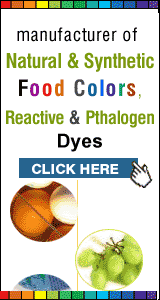|
Food additives have become a necessity of all
types of food products and food industry. Right from the aroma of the
beverage, the texture of the food and its visual appeal, has to be
enriched to make it acceptable. |
 |
Caramel
| Color |
Golden brown to dark brown |
| Source |
Burnt sugar and other carbohydrates |
| Solubility |
water |
| Stability |
¾ of the caramel contains
negative charge Acts as an emulsifier |
| Application |
baked goods, poultry, milk, canned
meats, syrups and soups |
Caramel Color Classification
- Class I is Plain Caramel Color
- Class II is Caustic Sulfite Process Caramel Color
- Class III is Ammonia Process Caramel Color
- Class IV is Sulfite Ammonia Process Caramel Color
|
Caramel color is one of the most widely used
colorants in foods. It is also called the color of burnt sugar. It is made
by heating food grade carbohydrates, generally a high dextrose-containing
starch hydrolysate or corn syrup. Acids such as acetic acid, citric acid,
lactic acid, or phosphoric acid may be used to break the bonds between
sugars before the sugars are raised to a higher temperature for
caramelization. Heat is carefully controlled during the process.
It can produce color ranging from light brown to almost black and this
color strength is called its tinctorial power (the absorbency at 560
nanometers measured by spectrophotometer). The color tone, as per the hue
index, measures the red characteristics of the color. The higher the
strength, the lower the hue index. Some caramel colors are termed "double
strength." This varies with the color range.
Caramel colour is a colloid . The specific gravity indicates the solids
content and the strength of the color. Being colloid, most of the caramel
color carry a positive or negative ionic charge. Negatively charged product
uses sulfite in its manufacture. The ionic charge of the caramel color
determines what caramel color should be used in what product.
This allows manufacturers to use negative colloidal caramel in acidic soft
drinks, and positive in beers and soy sauces. Caramel color is an
emulsifying agent as well. In soft drinks, it helps keep the flavor oils
suspended in the solution.
© Food Color World, All rights
reserved.
 Contact Now
Contact Now
Please
tell us your requirements related
to food colors & dyes. We will respond
to you as soon as possible.
 Send
Business Enquiry
Send
Business Enquiry 



